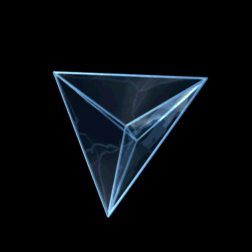
Pyron Theory is defined as a fundamental bottoms-up theory of the 3 dimensions of space.
"Time," an over-studied theory of our 3+1 dimensional Universe, is treated as insignificant for the time being. While important, "Time" is not thought of as "a dimension" so to speak, but rather as "a step," as a sequence of stacked realities of the "space" in which we live. The question before us is "Space," not "Time."
One of the greatest articles ever printed at Scientific American magazine,
"Atoms of Space and Time" by
Lee Smolin, is absolutely crucial reading in understanding this concept.
EDIT: On March 31, 2009 I became aware of the following T.O.E. website and find it intriguing ... in a "finding a needle in a haystack" sort of way:
http://www.toequest.com
Here is how I answered the introductory questions:
1. Where are you from?
New Jersey.
2. How did you locate the website?
It was linked at what I (and Scientific American) believe is the very best Introduction to Quantum Physics I have ever read, which is written and maintained by one Andrew Thomas in Wales, UK. It's "
What is Reality".
Previous to that website my favorite Introduction to Quantum Physics was Kenneth Ford's book. I've since discovered a better book that I strongly recommend:
The New Quantum Universe, by Tony Hey and Patrick Walters, but Andrew's website, being constantly updated, is my favorite.
3. What got you interested in the Theory of Everything?
First, let's define some terms. GUT = Grand Unified Theory which seeks to unite The Electroweak Force to The Strong Force. TOE = The Theory of Everything seeks to unite GUT with Gravity. I believe in crossing bridges in the order you come to them, so I seek to explain GUT first.
4. Do you have a unique perspective?
You bet. My focus is on how the Universe is structured at the Planck-scale of space/length/volume, and time. I seek to "unify" the Wave-Particle "Duality" which I call the WP Equality, with the seminal work of Louis de Broglie in the 1920's, which describes matter as having a wave nature, and the thought process of William (1285-1349) of Ockham (Occam), England, and the "razor" he was famous for applying to decrease complexity which is "Do not multiply a thing unnecessarily". In other words, keep it simple. It does NOT mean the simplest solution prevails, just that it usually does.
5. Where did you go to school and what did you study?
BSME = Bachelor's of Science of Mechanical Engineering at Rutgers University College of Engineering, specializing in Heat Transfer (Radiation, Conduction, Convection) which itself is a specialty of Thermodynamics. The other two branches of Mechanical Engineering are Fluid Dynamics, and Mechanics, of which Quantum Mechanics is a specialty.
MBA = Master of Business Administration at Rutgers Graduate School of Business Administration, where I specialized in the Mathematical side of business, as opposed to Marketing or Accounting and Finance. Lots of Linear Algebra. I like Math.
6. What areas are you most familiar with or interested in?
Quantum Gravity, therefore, Quantum Physics and General Relativity.
7. Have you written any books or publications?
I have a website on my Pyron Theory :
http://tetrahedral.blogspot.com/
I have also done work for The National Science Foundation re Heat Transfer, but that was long ago. In High School I won a Math Fair prize for a unique co-ordinate system called Spherical Plane Geometry.
8. What past influences have shaped your opinion of our world and its greater reality? This might be family, culture, education, various leaders, scientists, religion, personal experience, etc.
Far too many to list. Euclid, Newton, and Einstein for starters, and the other pioneers of Quantum Physics besides Einstein, notably Planck, Bohr, Born, Heisenberg, Pauli, de Broglie, Dirac, Schrodinger, Bohm, and J.S. Bell.
Currently I am excited at what Causal Dynamical Triangulations and Loop Quantum Gravity have to offer in explaining fundamental reality, and am exploring the Maths.
Here is my original
About Me:
I have too many interests to list, but my first loves that I have recently returned to are Mathematics, and Physics. The first book I ever read was The How and Why Book of Mathematics, at age 3. The second book was Codes and Secret Writing by Herbert Zim, at age 4. In my 2nd year of High School I won 2nd Place in a Math Fair that was open to all four grades. It was called "Spherical Plane Geometry." It was about 2-D co-ordinates on a 3-D object, and I knew nothing of Manifolds at the time. It began as many ideas begin, with an intuitive thought, combined with a rebellious nature. Taught that every triangle can never have angles that add up to more than 180 degrees, I envisioned a triangle that starts at the North Pole, runs due south to the equator, then around the globe ninety degrees, then up again to the North Pole. Such a triangle would then have three right angles (ninety degrees each). I have found "thinking outside the box" so to speak a great help in obtaining my Mechanical Engineering degree, an education I thoroughly enjoyed.
Here is a picture of Lee Smolin of the
Perimeter Institute for Theoretical Physics, whom I credit for getting me interested in Mathematical Physics again, and I'm sure I'm not the only one. Thank you, Lee.
 Lee Smolin (1955- )
Lee Smolin (1955- )


 Lee Smolin (1955- )
Lee Smolin (1955- )